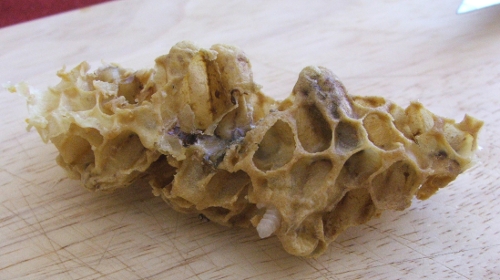This morning I had a visit from my county’s hive inspector. He was a nice man with almost 20 years of experience. We talked about Italian bees vs Carnolians, packages vs. swarms, treating versus letting the bees fight it out, win or loose. The inspection showed a good amount and variety of healthy bees, lots of brood – eggs, larvae, pupae – and quite a few frames loaded with honey.
We decided to take the honey super off. The bees had not drawn it out and wouldn’t do so anymore anyway. The inspector did confirm that I shouldn’t hesitate to pull one frame of honey from the top brood box. Amie’s allergies have been acting up and I am keen on gathering some of this local honey for her.
The inspector pulled out a clump of drone cells. Varroa mites are attracted to drone cells because drones take 4 more days to develop than workers. Safely and comfortably inside the capped cell with their defenseless victim, varroa destructor can have on average 2.2 – 2.6 offspring, compared to 1.3 – 1.4 offspring when on worker brood. The inspector burst one of the cells and we could immediately spot a mite. I brought the piece inside to show everyone at my house (that is, at the moment, 6 adults, 2 kids, 1 dog).
I sliced open the dark cell and so in fact released the drone that must have been just about to hatch.
After depositing the drone outside, I opened the larval cells and was disappointed to see that there were more mites, sometimes two, in each of them.
yeah, those are not eyes
Varroa does proliferate in Summer, so the minimal mite count in June no longer counts. I’ll put in another sticky board soon to see what the mite population is now.




Uh, oh…
Well drat. It’s great you have such an excellent local resource though. I hope that sticky board works.
mites=bad we have screen bottom boards. it think it helps?
I have a screened bottom board, so the mites that fall off fall through and out, and they can’t get back into the hive. The sticky board which I will put in for three days will trap them, so I will be able to count them.